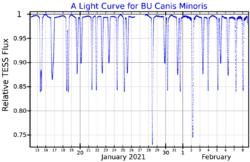Astronomy:BU Canis Minoris
| Observation data Equinox J2000.0]] (ICRS) | |
|---|---|
| Constellation | Canis Minor |
| Right ascension | 07h 58m 05.89734s[2] |
| Declination | 07° 12′ 48.7030″[2] |
| Apparent magnitude (V) | 6.42[3] |
| Characteristics | |
| Spectral type | A0V[4] |
| B−V color index | −0.031±0.008[3] |
| Astrometry | |
| Radial velocity (Rv) | +34.0±6.5[3] km/s |
| Proper motion (μ) | RA: −9.407[2] mas/yr Dec.: −11.835[2] mas/yr |
| Parallax (π) | 4.0663 ± 0.0568[2] mas |
| Distance | 800 ± 10 ly (246 ± 3 pc) |
| Absolute magnitude (MV) | −0.38[3] |
| Details[5] | |
| BU CMi Aa | |
| Mass | 3.40 ± 0.10 M☉ |
| Radius | 2.51 ± 0.05 R☉ |
| Surface gravity (log g) | 4.088 ± 0.010 cgs |
| Temperature | 10130 ± 80 K |
| BU CMi Ab | |
| Mass | 3.11 ± 0.10 M☉ |
| Radius | 1.80 ± 0.05 R☉ |
| Surface gravity (log g) | 4.338 ± 0.010 cgs |
| Temperature | 9740 ± 80 K |
| BU CMi Ba | |
| Mass | 3.29 ± 0.10 M☉ |
| Radius | 2.31 ± 0.05 R☉ |
| Surface gravity (log g) | 4.148 ± 0.010 cgs |
| Temperature | 10180 ± 80 K |
| BU CMi Bb | |
| Mass | 3.29 ± 0.10 M☉ |
| Radius | 2.04 ± 0.05 R☉ |
| Surface gravity (log g) | 4.259 ± 0.010 cgs |
| Temperature | 9890 ± 80 K |
| Other designations | |
| Database references | |
| SIMBAD | data |
BU Canis Minoris is a quadruple star system in the equatorial constellation of Canis Minor. It has the Henry Draper Catalogue designation of HD 65241, while BU Canis Minoris is its variable star designation. The system is a challenge to view with the naked eye, having a peak apparent visual magnitude of 6.42.[3] It is located at a distance of approximately 700 light years from the Sun based on parallax,[2] and is drifting further away with a radial velocity of about +34 km/s.[3]
In 2021, BU Canis Majoris was found to be composed to two eclipsing binaries, totalling four stars. Both pairs are double-lined spectroscopic binary systems that form Algol-like eclipsing binaries.[5] The orbits of both systems are somewhat eccentric.[5] The brightness of the system decreases from 6.44 down to 6.53 during the primary eclipse.[7] It has a stellar classification of A0V,[4] which matches an A-type main-sequence star that is generating energy through hydrogen fusion at its core. In reality, however, all four stars are nearly equal in properties, and have masses from 3.1 to 3.4 solar masses.[5] The system is about 200 million years old.[5]
References
- ↑ "MAST: Barbara A. Mikulski Archive for Space Telescopes". Space Telescope Science Institute. https://mast.stsci.edu/portal/Mashup/Clients/Mast/Portal.html.
- ↑ 2.0 2.1 2.2 2.3 2.4 2.5 Brown, A. G. A. (August 2018). "Gaia Data Release 2: Summary of the contents and survey properties". Astronomy & Astrophysics 616: A1. doi:10.1051/0004-6361/201833051. Bibcode: 2018A&A...616A...1G. Gaia DR2 record for this source at VizieR.
- ↑ 3.0 3.1 3.2 3.3 3.4 3.5 Anderson, E.; Francis, Ch. (2012), "XHIP: An extended hipparcos compilation", Astronomy Letters 38 (5): 331, doi:10.1134/S1063773712050015, Bibcode: 2012AstL...38..331A.
- ↑ 4.0 4.1 Cowley, A.; Cowley, C.; Jaschek, M.; Jaschek, C. (April 1969), "A study of the bright A stars. I. A catalogue of spectral classifications", Astronomical Journal 74: 375–406, doi:10.1086/110819, Bibcode: 1969AJ.....74..375C
- ↑ 5.0 5.1 5.2 5.3 5.4 Volkov, I. M.; Kravtsova, A. S.; Chochol, D. (2021). "BU CMi as a Quadruple Doubly Eclipsing System". Astronomy Reports 65 (9): 826–838. doi:10.1134/S1063772921090080. Bibcode: 2021ARep...65..826V.
- ↑ "BU CMi". SIMBAD. Centre de données astronomiques de Strasbourg. http://simbad.u-strasbg.fr/simbad/sim-basic?Ident=BU+CMi.
- ↑ Samus, N. N. et al. (2017), "General Catalogue of Variable Stars", Astronomy Reports, 5.1 61 (1): 80–88, doi:10.1134/S1063772917010085, Bibcode: 2017ARep...61...80S.
 |


